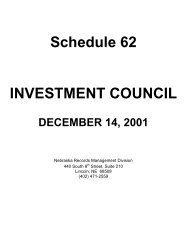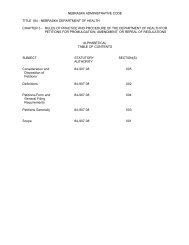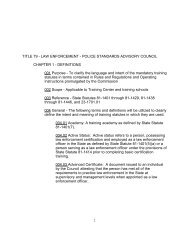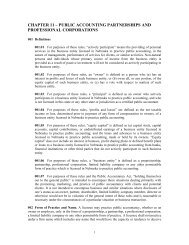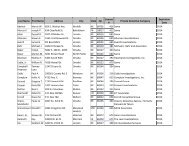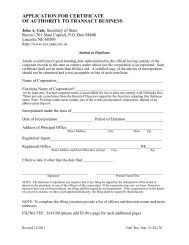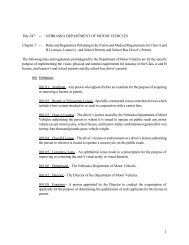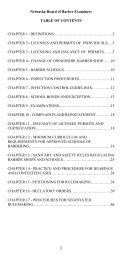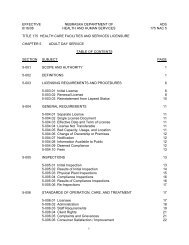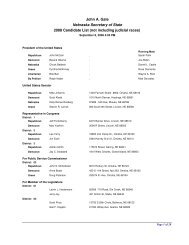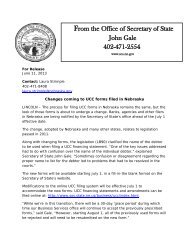Title 172 Chapter 99 - Nebraska Secretary of State
Title 172 Chapter 99 - Nebraska Secretary of State
Title 172 Chapter 99 - Nebraska Secretary of State
Create successful ePaper yourself
Turn your PDF publications into a flip-book with our unique Google optimized e-Paper software.
EFFECTIVE NEBRASKA HEALTH AND HUMAN SERVICES<br />
11/17/04 REGULATION AND LICENSURE <strong>172</strong> NAC <strong>99</strong><br />
<strong>99</strong>-006.03 Standards for assignments by licensed nurses to unlicensed persons. RNs and<br />
LPNs must:<br />
1. make assignments only to those unlicensed persons authorized through delegation<br />
from the RN in accordance with <strong>172</strong> NAC <strong>99</strong>-004.01, and<br />
2. determine assignments within the framework <strong>of</strong> the delegation plan as described in<br />
<strong>172</strong> NAC <strong>99</strong>-004.01C item 2. RNs and LPNs may limit assignment(s) according to<br />
competency <strong>of</strong> the unlicensed person and the current nursing care needs <strong>of</strong> the<br />
client/patient condition.<br />
<strong>99</strong>-007 APPROPRIATE ROLE OF THE LPN IN INTRAVENOUS THERAPY: This section is<br />
intended to define appropriate nursing interventions, based on the LPN's knowledge and skills<br />
acquired in an approved practical nursing educational program, which the LPN may accept as a<br />
directed activity related to intravenous therapy. The interventions must be within the scope <strong>of</strong><br />
practice <strong>of</strong> the licensed practitioner or registered nurse directing the activity.<br />
<strong>99</strong>-007.01 Acceptance <strong>of</strong> directed activities related to intravenous therapy. A LPN may<br />
accept responsibility for provision <strong>of</strong> the following interventions:<br />
1. Assisting in initiating intravenous therapy;<br />
2. Monitoring the rate <strong>of</strong> flow;<br />
3. Temporarily slowing the rate <strong>of</strong> flow and reporting observations;<br />
4. Discontinuing peripheral intravenous catheters that are no more than three inches<br />
in length;<br />
5. Assisting in the administration <strong>of</strong> blood transfusions, hypodermoclysis, and<br />
hyperalimentation;<br />
6. Regulating the rate <strong>of</strong> flow including the use <strong>of</strong> regulatory equipment;<br />
7. Adding intravenous solutions to an established peripheral line, excluding those on<br />
pediatric clients. Solutions must be unmedicated, commercially prepared or<br />
prepared by a pharmacist or registered nurse, and may include vitamins and/or KCl.<br />
Acceptable intravenous solutions are limited to those fluids that are generally used<br />
as maintenance and isotonic in nature; and<br />
8. Changing <strong>of</strong> intravenous tubing for peripheral lines only.<br />
<strong>99</strong>-007.02 Activities related to intravenous therapy which a licensed practical nurse MAY NOT<br />
accept as directed activities include but are not limited to:<br />
1. Venipuncture for purposes <strong>of</strong> initiating intravenous therapy;<br />
21



